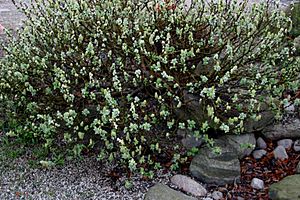Woolly willow facts for kids
Quick facts for kids Woolly willow |
|
|---|---|
 |
|
| Scientific classification | |
| Genus: |
Salix
|
| Species: |
lanata
|
Salix lanata, also known as the woolly willow, is a special type of willow plant. It grows naturally in cold, northern parts of the world, like Iceland, the Faroe Islands, northern Scandinavia (which includes Norway, Sweden, and Finland), and all the way to eastern Siberia in Russia. In Scotland, you can find it in only a few places, usually on rocky mountain sides high up, between 600 and 900 meters (about 2,000 to 3,000 feet) above sea level.
Contents
What is the Woolly Willow?
The woolly willow is a small, bushy shrub that loses its leaves in winter. This means it is a deciduous plant. It usually grows less than 100 centimeters (about 3 feet) tall and spreads out about 150 centimeters (about 5 feet) wide.
Leaves and Branches
When new branches grow, they are soft and hairy. But soon, they become smooth and brown. The leaves are grey-green and can look a bit different from one plant to another. They are usually oval-shaped, up to 7 centimeters (about 2.7 inches) long and 6.5 centimeters (about 2.5 inches) wide. When they are young, the leaves are covered in soft, silvery-grey "wool." As they get older, they lose some of this wool. The edges of the leaves are usually smooth.
Flowers and Reproduction
The woolly willow has special flowers called catkins. These catkins appear in summer, usually from May to July. Like all willows, this plant is dioecious. This means that male catkins and female catkins grow on separate plants. So, one plant will have only male flowers, and another plant will have only female flowers. The female catkins are very hairy.
The small stems that hold the leaves, called petioles, are usually less than 1 centimeter long. At the base of the leaf stem, there are small leaf-like parts called stipules. These are usually about 1 centimeter long and 0.6 centimeters wide, and they stay on the plant for a long time.
Why is the Woolly Willow Special?
The woolly willow is a great plant for gardens because of its interesting texture, color, and compact shape. It is also extremely tough and can survive very cold weather. Because of these good qualities, the Royal Horticultural Society has given it their Award of Garden Merit. This award means it is an excellent plant for growing in gardens.
See also
 In Spanish: Salix lanata para niños
In Spanish: Salix lanata para niños

